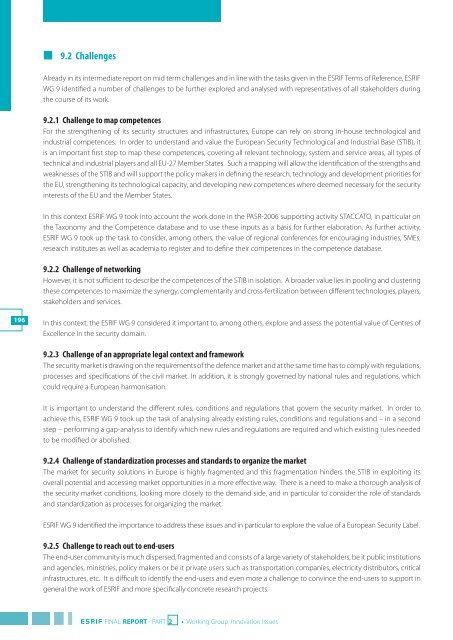I527-290 ESRIF Final Report (WEB).indd - European Commission
I527-290 ESRIF Final Report (WEB).indd - European Commission
I527-290 ESRIF Final Report (WEB).indd - European Commission
You also want an ePaper? Increase the reach of your titles
YUMPU automatically turns print PDFs into web optimized ePapers that Google loves.
196<br />
9.2 Challenges<br />
Already in its intermediate report on mid term challenges and in line with the tasks given in the <strong>ESRIF</strong> Terms of Reference, <strong>ESRIF</strong><br />
WG 9 identifi ed a number of challenges to be further explored and analysed with representatives of all stakeholders during<br />
the course of its work.<br />
9.2.1 Challenge to map competences<br />
For the strengthening of its security structures and infrastructures, Europe can rely on strong in-house technological and<br />
industrial competences. In order to understand and value the <strong>European</strong> Security Technological and Industrial Base (STIB), it<br />
is an important fi rst step to map these competences, covering all relevant technology, system and service areas, all types of<br />
technical and industrial players and all EU-27 Member States. Such a mapping will allow the identifi cation of the strengths and<br />
weaknesses of the STIB and will support the policy makers in defi ning the research, technology and development priorities for<br />
the EU, strengthening its technological capacity, and developing new competences where deemed necessary for the security<br />
interests of the EU and the Member States.<br />
In this context <strong>ESRIF</strong> WG 9 took into account the work done in the PASR-2006 supporting activity STACCATO, in particular on<br />
the Taxonomy and the Competence database and to use these inputs as a basis for further elaboration. As further activity,<br />
<strong>ESRIF</strong> WG 9 took up the task to consider, among others, the value of regional conferences for encouraging industries, SMEs,<br />
research institutes as well as academia to register and to defi ne their competences in the competence database.<br />
9.2.2 Challenge of networking<br />
However, it is not suffi cient to describe the competences of the STIB in isolation. A broader value lies in pooling and clustering<br />
these competences to maximize the synergy, complementarity and cross-fertilization between diff erent technologies, players,<br />
stakeholders and services.<br />
In this context, the <strong>ESRIF</strong> WG 9 considered it important to, among others, explore and assess the potential value of Centres of<br />
Excellence in the security domain.<br />
9.2.3 Challenge of an appropriate legal context and framework<br />
The security market is drawing on the requirements of the defence market and at the same time has to comply with regulations,<br />
processes and specifi cations of the civil market. In addition, it is strongly governed by national rules and regulations, which<br />
could require a <strong>European</strong> harmonisation.<br />
It is important to understand the diff erent rules, conditions and regulations that govern the security market. In order to<br />
achieve this, <strong>ESRIF</strong> WG 9 took up the task of analysing already existing rules, conditions and regulations and – in a second<br />
step – performing a gap-analysis to identify which new rules and regulations are required and which existing rules needed<br />
to be modifi ed or abolished.<br />
9.2.4 Challenge of standardization processes and standards to organize the market<br />
The market for security solutions in Europe is highly fragmented and this fragmentation hinders the STIB in exploiting its<br />
overall potential and accessing market opportunities in a more eff ective way. There is a need to make a thorough analysis of<br />
the security market conditions, looking more closely to the demand side, and in particular to consider the role of standards<br />
and standardization as processes for organizing the market.<br />
<strong>ESRIF</strong> WG 9 identifi ed the importance to address these issues and in particular to explore the value of a <strong>European</strong> Security Label.<br />
9.2.5 Challenge to reach out to end-users<br />
The end-user community is much dispersed, fragmented and consists of a large variety of stakeholders, be it public institutions<br />
and agencies, ministries, policy makers or be it private users such as transportation companies, electricity distributors, critical<br />
infrastructures, etc. It is diffi cult to identify the end-users and even more a challenge to convince the end-users to support in<br />
general the work of <strong>ESRIF</strong> and more specifi cally concrete research projects.<br />
<strong>ESRIF</strong> FINAL REPORT - PART 2 • Working Group: Innovation Issues

















